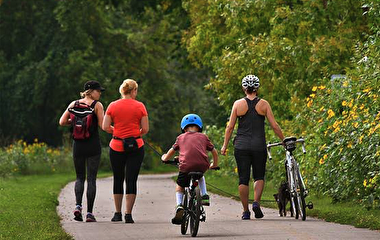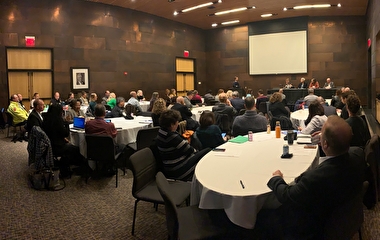In the opening presentation of the 2019 CTS Transportation Research Conference, SharedStreets co-director Kevin Webb examined how the emerging “digital layers” of the public realm are affecting transportation and urban governance. Immediately following his presentation, a panel of Minnesota leaders and experts shared their perspectives on managing digital data and new mobility in today’s complex transportation industry.
Steve Elkins, Representative, Minnesota House of Representatives
“In an era of shared mobility services, governments will need data to manage the demand on street grids and curbs. What happens when everyone is summoning a shared vehicle to drop them off at the front door of the company headquarters at the same time? The curb will be hugely important, and if every vehicle drops off and then starts circulating downtown waiting for its next ride, the streets will be gridlocked. We are going to need data on where vehicles are dropping off, where they are accumulating, and have some kind of pricing mechanism to regulate these flows and spread them out. This will require some very granular, real-time data to enable cities or regional governments to manage these flows.”
Robin Hutcheson, Director of Public Works, City of Minneapolis
“Our engineers investigated how much of the City of Minneapolis is actually within the right-of-way, and we learned that the right-of-way makes up 22 percent of the city. When you look at the definition of right-of-way, it is ‘land that we hold in trust for the public.’ The biggest risk I see in this technological transportation boom is having that slip away from us. In order to protect our right-of-way and ensure it benefits the public, our city needs to reshape, reframe, and reskill ourselves to address this risk.”
Andrew Owen, Director and Research Fellow, Accessibility Observatory, University of Minnesota
“The risk generator underneath all this is that urban transportation is typically a low-margin or money-losing business, and therefore companies that operate urban transportation need to find ways to be profitable. However, the methods they use to make a profit often run counter to the public good. For example, they can dump supply onto the system and cause competitors to drop out, practice supply discrimination and cause certain users to wait longer for trips, or practice price discrimination by charging users different prices for the same service. The challenge for governments is to regulate in a way that ensures there is some profit left to allow companies to provide the service without destroying our cities in the process.”
Russ Stark, Chief Resilience Officer, City of Saint Paul
“From a city perspective, but also from a resident and community perspective, there is a risk of services popping up and then disappearing after people have become reliant on those services, and in some cases even organized their lives around them. As local governments, at least initially, we’ve been unable to react at the speed of the private sector to these changes, and to determine the best approach to achieve the public good. I believe we have an obligation in the public sector to set expectations for services to work for our communities and, if we value them, ensure that they be sustained over time.”



